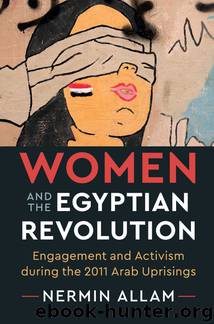Women and the Egyptian Revolution by Allam Nermin

Author:Allam, Nermin
Language: eng
Format: epub
Publisher: Cambridge University Press
Published: 2017-12-12T00:00:00+00:00
Another protestor mocked the practice, asking: “Do we need to move surrounded by a bubble in every public space?”66 In-depth research on the phenomenon of sexual harassment in Egypt, such as the studies done by Nazra for feminist studies, see the resurgence of sexual harassment as an attempt to exclude women from the political and public space and to break the movement as a whole (see also Rizzo et al. 2012). The name of the group “Nazra” means the gaze, and in line with its name, the group aims to direct the society’s gaze to women’s rights and gender issues. Through knowledge production and documentation, strategic litigation, networking, and advocacy for gender issues, the organization works toward building an Egyptian feminist movement with the understanding that feminism and gender are political and social issues. Building upon their extensive interviews with survivors of sexual assault, they concluded that the process is a “deliberate” and “organized effort”67 carried out on behalf of some political sects in the society to exclude women from participating in the public sphere and to break the will of their male counterparts (Nazra 2012, 2013).
In an unpublished report titled “Tajmiʿ Shahadat ḥawl Al-Iʿtidaʾat Al-Jinsyah wa Al-Ightiṣab Al-Jamaʿī fi Midan Al-Tahrir wa Muḥituh Al-waqiʿa Ma Byn 2011–2013” [A Collection of Testimonies of Sexual Harassment and Rape Incidents in Tahrir Square and its Vicinity 2011–2013], researchers at Nazra, El-Nadeem Centre for Rehabilitation of Victims of Violence and the New Women Organization, compiled the testimonies of twenty-eight survivors of collective sexual assault and harassment that took place in the vicinity of Tahrir Square between 2011 and 2013.68 The testimonies describe how women were being groped by tens of men and how the sexual assaults included raping women using knives.69 The pattern is the same in all the testimonies: two circles form, one surrounding the victim and assaulting her and the other fence the group and push off anyone who might try to rescue the victim. The victim is unable to tell who is helping and who is assaulting, one survivor describes: “I didn’t know who was trying to help and who wasn’t. Some were really just helping and others were pretending to help but actually touching my body parts.”70 In the same report, another survivor illustrates: “they were not using sexual phrases as you would expect; some kept repeating, ‘you are like my sister, do not worry’; but these were the same people pulling down my pants!”71
A volunteer at the OpAntiSH explained how the operation had to change their rescue plans by assigning female rather than male volunteers to rescue and intervene in operations.72 As part of the intervention and rescue force, female volunteers stepped into mob assaults and tried to rescue the victim. This is because, another volunteer at the OpAntiSH explained, “at this point, the victim is very suspicious of any man.”73 The level of violence involved as well, Salma El-Nakash, director of Women’s Political Participation program at Nazra describes, is often extreme.74 Ghada Lotfy, director at the Egyptian
Download
Women and the Egyptian Revolution by Allam Nermin.epub
This site does not store any files on its server. We only index and link to content provided by other sites. Please contact the content providers to delete copyright contents if any and email us, we'll remove relevant links or contents immediately.
| Arms Control | Diplomacy |
| Security | Trades & Tariffs |
| Treaties | African |
| Asian | Australian & Oceanian |
| Canadian | Caribbean & Latin American |
| European | Middle Eastern |
| Russian & Former Soviet Union |
The Secret History by Donna Tartt(18862)
The Social Justice Warrior Handbook by Lisa De Pasquale(12143)
Thirteen Reasons Why by Jay Asher(8801)
This Is How You Lose Her by Junot Diaz(6803)
Weapons of Math Destruction by Cathy O'Neil(6152)
Zero to One by Peter Thiel(5693)
Beartown by Fredrik Backman(5609)
The Myth of the Strong Leader by Archie Brown(5429)
The Fire Next Time by James Baldwin(5253)
How Democracies Die by Steven Levitsky & Daniel Ziblatt(5134)
Promise Me, Dad by Joe Biden(5090)
Stone's Rules by Roger Stone(5029)
A Higher Loyalty: Truth, Lies, and Leadership by James Comey(4851)
100 Deadly Skills by Clint Emerson(4845)
Rise and Kill First by Ronen Bergman(4706)
Secrecy World by Jake Bernstein(4653)
The David Icke Guide to the Global Conspiracy (and how to end it) by David Icke(4629)
The Farm by Tom Rob Smith(4442)
The Doomsday Machine by Daniel Ellsberg(4420)
